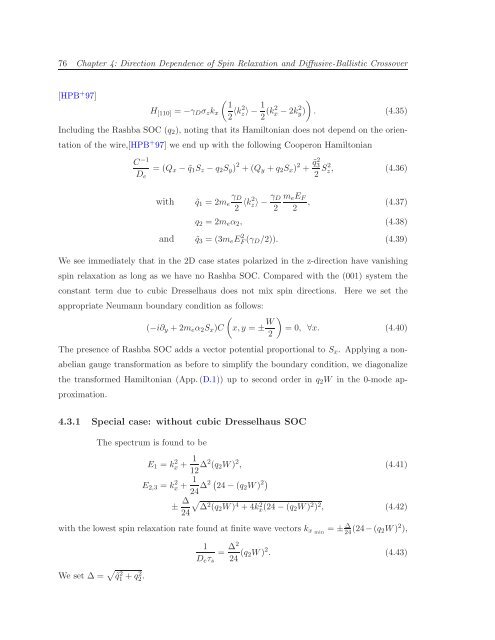Itinerant Spin Dynamics in Structures of ... - Jacobs University
Itinerant Spin Dynamics in Structures of ... - Jacobs University
Itinerant Spin Dynamics in Structures of ... - Jacobs University
You also want an ePaper? Increase the reach of your titles
YUMPU automatically turns print PDFs into web optimized ePapers that Google loves.
76 Chapter 4: Direction Dependence <strong>of</strong> <strong>Sp<strong>in</strong></strong> Relaxation and Diffusive-Ballistic Crossover<br />
[HPB + 97]<br />
( 1<br />
H [110] = −γ D σ z k x<br />
2 〈k2 z〉− 1 )<br />
2 (k2 x −2ky)<br />
2 . (4.35)<br />
Includ<strong>in</strong>g the Rashba SOC (q 2 ), not<strong>in</strong>g that its Hamiltonian does not depend on the orientation<br />
<strong>of</strong> the wire,[HPB + 97] we end up with the follow<strong>in</strong>g Cooperon Hamiltonian<br />
C −1<br />
D e<br />
= (Q x − ˜q 1 S z −q 2 S y ) 2 +(Q y +q 2 S x ) 2 + ˜q2 3<br />
2 S2 z , (4.36)<br />
with<br />
˜q 1 = 2m e<br />
γ D<br />
2 〈k2 z〉− γ D<br />
2<br />
m e E F<br />
2<br />
, (4.37)<br />
q 2 = 2m e α 2 , (4.38)<br />
and ˜q 3 = (3m e E 2 F(γ D /2)). (4.39)<br />
We see immediately that <strong>in</strong> the 2D case states polarized <strong>in</strong> the z-direction have vanish<strong>in</strong>g<br />
sp<strong>in</strong> relaxation as long as we have no Rashba SOC. Compared with the (001) system the<br />
constant term due to cubic Dresselhaus does not mix sp<strong>in</strong> directions. Here we set the<br />
appropriate Neumann boundary condition as follows:<br />
(<br />
(−i∂ y +2m e α 2 S x )C x,y = ± W )<br />
= 0, ∀x. (4.40)<br />
2<br />
The presence <strong>of</strong> Rashba SOC adds a vector potential proportional to S x . Apply<strong>in</strong>g a nonabelian<br />
gauge transformation as before to simplify the boundary condition, we diagonalize<br />
the transformed Hamiltonian (App.(D.1)) up to second order <strong>in</strong> q 2 W <strong>in</strong> the 0-mode approximation.<br />
4.3.1 Special case: without cubic Dresselhaus SOC<br />
The spectrum is found to be<br />
E 1 = k 2 x + 1<br />
12 ∆2 (q 2 W) 2 , (4.41)<br />
E 2,3 = k 2 x + 1<br />
24 ∆2( 24−(q 2 W) 2)<br />
± ∆ 24√<br />
∆ 2 (q 2 W) 4 +4k 2 x (24−(q 2W) 2 ) 2 , (4.42)<br />
with the lowest sp<strong>in</strong> relaxation rate found at f<strong>in</strong>ite wave vectors k x m<strong>in</strong><br />
= ± ∆ 24 (24−(q 2W) 2 ),<br />
We set ∆ = √˜q 2 1 +q2 2 .<br />
1<br />
D e τ s<br />
= ∆2<br />
24 (q 2W) 2 . (4.43)
















